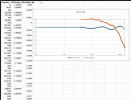- Joined
- Jun 5, 2016
- Messages
- 2,898
- Likes
- 4,738
I'm trying to figure out a math problem that I thought would be easy but is ending up being more difficult than I expected. I'm trying to create a 90 deg cal file for an Earthworks M30. I have the current cal file ("ECF") as well as a "90 deg typical response" ECF from Earthworks. So I want to modify the mic's ECF to incorporate the HF compensation from the "typical response" file.
I've attached both files here.
PS: I realize I could crate a 90 deg cal file using John Reekie's method but I want to see if it can be done without introducing error from mic tip placement variation at HF in acoustic measurements.
I've attached both files here.
PS: I realize I could crate a 90 deg cal file using John Reekie's method but I want to see if it can be done without introducing error from mic tip placement variation at HF in acoustic measurements.


